Depth of Field, Part 3:
Hyperfocal Distance
Presented by Scott Ballard
Written by Tim Park and Scott Ballard
Summary: Something interesting happens to the depth of field when the subject distance changes. As the camera gets closer to the subject, the depth of field gets smaller and more compressed, but when the camera distance increases the depth of field expands.
At a special distance the far focal limit reaches infinity long before the focal plane gets anywhere close to this far. Sometimes this is just a few feet from the camera! This means you can have the distant horizon in focus plus a lot of foreground without needing to focus very far in front of the camera. This distance is called the hyperfocal distance.
Length: 6:23 minutes
!! Want to see the whole video? Become a member !!
- If you are already a member, you can log in below.
Introduction
When we talk about depth of field, it is important to understand hyperfocal distance. As we mentioned in previous lessons, depth of field is the distance between the nearest and farthest objects in your frame that appear acceptably sharp, that are in focus. Anything behind or in front of that range will not be in focus and get gradually more blurry the farther away they are from this in-focus range.
However, there is a specific distance where the depth of field range is the largest it can possibly be because the range goes to infinity. EVERYTHING behind the focus point along with some in front is all in focus. This is called the hyperfocal distance. When you focus your lens to this distance everything behind the subject will be in focus without having to focus the lens to infinity. Pretty cool, right?
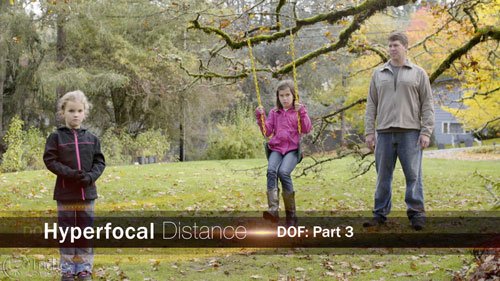
To understand the hyperfocal distance, we should first look at some normal DOF situations. Let’s say we are using a 50mm lens with an f/4.0 aperture our subject is 18 feet from the camera. With these settings we have about a 10 foot range that is acceptably in focus. Anything outside this 10 foot range will be soft and we’d have to adjust or rack our focus for it to appear sharp. An important aspect of these settings is that the subject is not centered in the middle of that 10 foot DOF. Instead our talent is about a third the way into this ten foot range, so they have about 3 ½ feet in front and about 6 ½ ft behind them to move and still be in focus. So if our talent is swinging on a swing, they will be in focus more on the back half than on the front half of the swing.
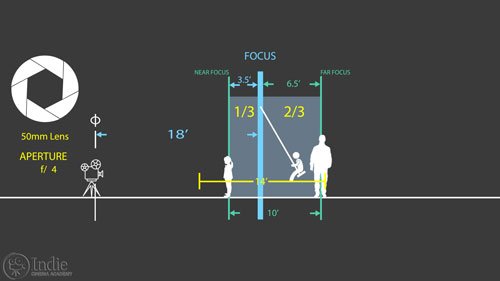
You’ll hear that as a general rule of thumb, a subject has ⅓ their distance from the camera is in focus as well as ⅔ their distance behind. However this rule only works in a narrow range of settings and really depends on the aperture and the subject’s distance from camera. This last example happens to have the camera settings to follow the rule. But let’s see what happens as the distance between the camera and talent gets smaller...
** Want to read the rest of the transcript? Become a member. **
Camera / Audio
- Sony Alpha a7S Mirrorless Digital Camera
- Rokinon Cine DS 6 Lens Kit with Sony E Mount
- Bright Tangerine Misfit Matte Box
- TruND Neutral Density Filters (4″x5.65″): 0.3, 0.6, 0.9, 1.2, 1.5
- Schneider Neutral Density Filters (4″x5.65″): 0.3, 0.6, 0.9, 1.2, 1.5
- Tilta FF-T03 15mm Follow Focus with Hard Stops
- Sachtler Panorama 7+7 Head 100mm (similar head: 1006 DV 10 SB Fluid Head)
- Sachtler Carbon Fiber Tripod (similar tripod: Carbon Fiber HD Tripod Legs)
- Movcam Cage for Sony A7S
- Wooden Camera A/B Gold-Mount Plate for Sony A7, A7r and A7s
- Audio Technica AT835b Shotgun Microphone
(similar microphone: Audio Technica BP4071 Shotgun Microphone)
- Wooden Camera DSLR A-Box
- Delkin Devices 64GB SDXC Memory Card 600x UHS-I
- DSC Labs One Shot Reference Chart (Matte Finish)
Behind the Scenes (BTS) Cameras
- GoPro Hero3 Black (similar camera: GoPro HERO4 Black)
Lighting / Grip Gear
 https://indiecinemaacademy.com/wp-content/uploads/2017/01/DoF05_Circle_of_Confusion_and_Diffraction-Thumbnail.jpg
450
800
Tim
https://indiecinemaacademy.com/wp-content/uploads/2013/12/Indie_cinema_Logo_2color-MF-300x116-web.png
Tim2017-01-08 22:45:252025-03-11 14:50:12Depth of Field, Part 5: How Circle of Confusion and Diffraction Blur Your Image
https://indiecinemaacademy.com/wp-content/uploads/2017/01/DoF05_Circle_of_Confusion_and_Diffraction-Thumbnail.jpg
450
800
Tim
https://indiecinemaacademy.com/wp-content/uploads/2013/12/Indie_cinema_Logo_2color-MF-300x116-web.png
Tim2017-01-08 22:45:252025-03-11 14:50:12Depth of Field, Part 5: How Circle of Confusion and Diffraction Blur Your Image https://indiecinemaacademy.com/wp-content/uploads/2016/11/ICA_DOF04_Using_a_DOF_Calculator-Thumbnail-web.jpg
450
800
Tim
https://indiecinemaacademy.com/wp-content/uploads/2013/12/Indie_cinema_Logo_2color-MF-300x116-web.png
Tim2016-11-22 13:39:542025-03-11 14:49:44Depth of Field Part 4: Using a DOF Calculator + Advanced Tips and Tricks
https://indiecinemaacademy.com/wp-content/uploads/2016/11/ICA_DOF04_Using_a_DOF_Calculator-Thumbnail-web.jpg
450
800
Tim
https://indiecinemaacademy.com/wp-content/uploads/2013/12/Indie_cinema_Logo_2color-MF-300x116-web.png
Tim2016-11-22 13:39:542025-03-11 14:49:44Depth of Field Part 4: Using a DOF Calculator + Advanced Tips and Tricks https://indiecinemaacademy.com/wp-content/uploads/2016/11/ICA_DOF03_Hyperfocal_Distance-Thumbnail.jpg
450
800
Tim
https://indiecinemaacademy.com/wp-content/uploads/2013/12/Indie_cinema_Logo_2color-MF-300x116-web.png
Tim2016-11-07 01:15:062025-03-11 14:48:57Depth of Field, Part 3: Hyperfocal Distance
https://indiecinemaacademy.com/wp-content/uploads/2016/11/ICA_DOF03_Hyperfocal_Distance-Thumbnail.jpg
450
800
Tim
https://indiecinemaacademy.com/wp-content/uploads/2013/12/Indie_cinema_Logo_2color-MF-300x116-web.png
Tim2016-11-07 01:15:062025-03-11 14:48:57Depth of Field, Part 3: Hyperfocal Distance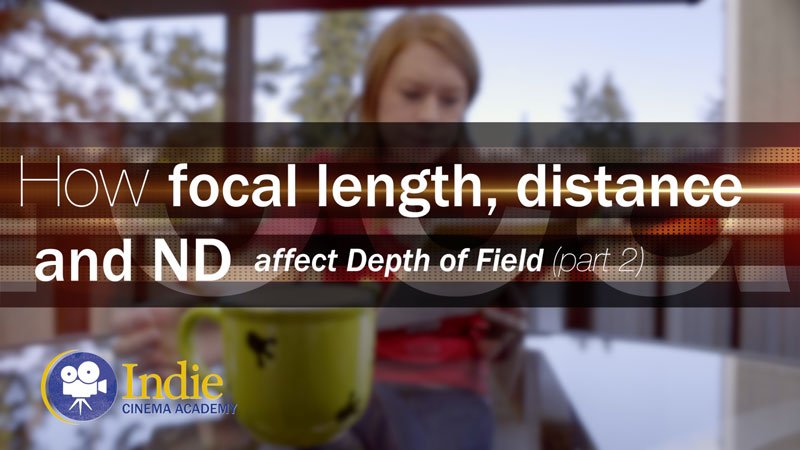 https://indiecinemaacademy.com/wp-content/uploads/2016/10/ICA_DoF02_Distance_and_ND_Filters-Thumbnail_web.jpg
450
800
Tim
https://indiecinemaacademy.com/wp-content/uploads/2013/12/Indie_cinema_Logo_2color-MF-300x116-web.png
Tim2016-10-24 08:00:022025-03-11 14:48:27Depth of Field Part 2: How Focal Length, Distance, and ND Affect Depth of Field
https://indiecinemaacademy.com/wp-content/uploads/2016/10/ICA_DoF02_Distance_and_ND_Filters-Thumbnail_web.jpg
450
800
Tim
https://indiecinemaacademy.com/wp-content/uploads/2013/12/Indie_cinema_Logo_2color-MF-300x116-web.png
Tim2016-10-24 08:00:022025-03-11 14:48:27Depth of Field Part 2: How Focal Length, Distance, and ND Affect Depth of Field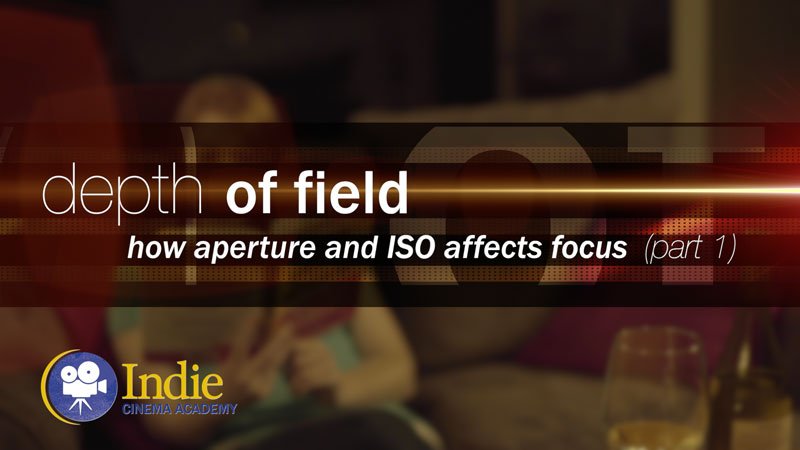 https://indiecinemaacademy.com/wp-content/uploads/2016/10/ICA_DoF01_How_Aperture_and_ISO_Affects_Focus-Thumbnail-web.jpg
450
800
Tim
https://indiecinemaacademy.com/wp-content/uploads/2013/12/Indie_cinema_Logo_2color-MF-300x116-web.png
Tim2016-10-10 00:15:202025-03-11 14:46:47Depth of Field, Part 1: How Aperture and ISO Affect Focus
https://indiecinemaacademy.com/wp-content/uploads/2016/10/ICA_DoF01_How_Aperture_and_ISO_Affects_Focus-Thumbnail-web.jpg
450
800
Tim
https://indiecinemaacademy.com/wp-content/uploads/2013/12/Indie_cinema_Logo_2color-MF-300x116-web.png
Tim2016-10-10 00:15:202025-03-11 14:46:47Depth of Field, Part 1: How Aperture and ISO Affect Focus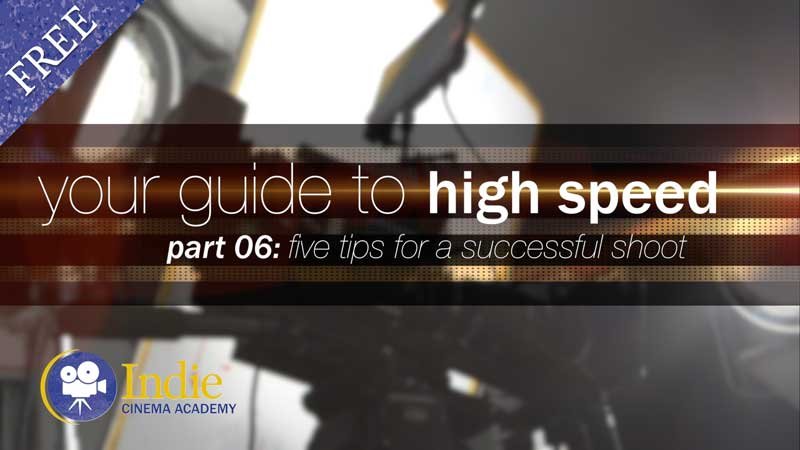 https://indiecinemaacademy.com/wp-content/uploads/2015/12/CS006-HighSpeed-Part06-FREE-Thumbnail-Web.jpg
450
800
Ryan E. Walters
https://indiecinemaacademy.com/wp-content/uploads/2013/12/Indie_cinema_Logo_2color-MF-300x116-web.png
Ryan E. Walters2015-12-14 00:15:052015-12-29 13:20:06Your Guide To High Speed, Part 6: Five Tips For A Successful Shoot
https://indiecinemaacademy.com/wp-content/uploads/2015/12/CS006-HighSpeed-Part06-FREE-Thumbnail-Web.jpg
450
800
Ryan E. Walters
https://indiecinemaacademy.com/wp-content/uploads/2013/12/Indie_cinema_Logo_2color-MF-300x116-web.png
Ryan E. Walters2015-12-14 00:15:052015-12-29 13:20:06Your Guide To High Speed, Part 6: Five Tips For A Successful Shoot https://indiecinemaacademy.com/wp-content/uploads/2015/12/CS005-HighSpeed-Part05-FREE-Thumbnail-Web.jpg
450
800
Ryan E. Walters
https://indiecinemaacademy.com/wp-content/uploads/2013/12/Indie_cinema_Logo_2color-MF-300x116-web.png
Ryan E. Walters2015-11-30 09:00:282015-12-29 15:41:16Your Guide To High Speed, Part 5: Lighting Six High Speed Sets
https://indiecinemaacademy.com/wp-content/uploads/2015/12/CS005-HighSpeed-Part05-FREE-Thumbnail-Web.jpg
450
800
Ryan E. Walters
https://indiecinemaacademy.com/wp-content/uploads/2013/12/Indie_cinema_Logo_2color-MF-300x116-web.png
Ryan E. Walters2015-11-30 09:00:282015-12-29 15:41:16Your Guide To High Speed, Part 5: Lighting Six High Speed Sets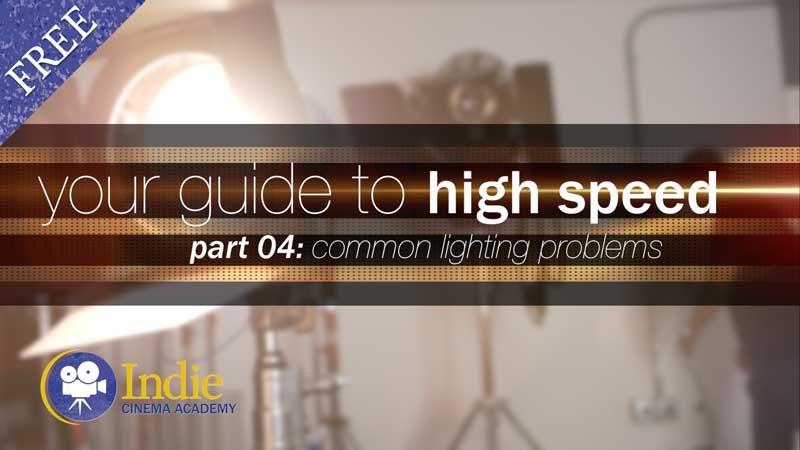 https://indiecinemaacademy.com/wp-content/uploads/2015/12/CS004-HighSpeed-Part04-FREE-Thumbnail-Web.jpg
450
800
Ryan E. Walters
https://indiecinemaacademy.com/wp-content/uploads/2013/12/Indie_cinema_Logo_2color-MF-300x116-web.png
Ryan E. Walters2015-11-16 00:15:182015-12-29 13:17:26Your Guide To High Speed, Part 4: Common Lighting Problems
https://indiecinemaacademy.com/wp-content/uploads/2015/12/CS004-HighSpeed-Part04-FREE-Thumbnail-Web.jpg
450
800
Ryan E. Walters
https://indiecinemaacademy.com/wp-content/uploads/2013/12/Indie_cinema_Logo_2color-MF-300x116-web.png
Ryan E. Walters2015-11-16 00:15:182015-12-29 13:17:26Your Guide To High Speed, Part 4: Common Lighting Problems https://indiecinemaacademy.com/wp-content/uploads/2015/12/CS003-HighSpeed-Part03-FREE-Thumbnail-Web.jpg
450
800
Ryan E. Walters
https://indiecinemaacademy.com/wp-content/uploads/2013/12/Indie_cinema_Logo_2color-MF-300x116-web.png
Ryan E. Walters2015-11-02 00:15:272015-12-29 13:15:49Your Guide To High Speed, Part 3: Camera Operation & Workflow
https://indiecinemaacademy.com/wp-content/uploads/2015/12/CS003-HighSpeed-Part03-FREE-Thumbnail-Web.jpg
450
800
Ryan E. Walters
https://indiecinemaacademy.com/wp-content/uploads/2013/12/Indie_cinema_Logo_2color-MF-300x116-web.png
Ryan E. Walters2015-11-02 00:15:272015-12-29 13:15:49Your Guide To High Speed, Part 3: Camera Operation & Workflow
Leave a Reply
Want to join the discussion?Feel free to contribute!